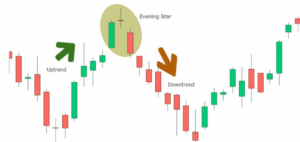When it comes to forex candlestick patterns, few are as reliable for spotting reversals as the Morning Doji Star and Evening Doji Star. These are not just textbook examples — traders use them every day to anticipate when momentum is fading and a trend is about to reverse. If you can master these setups, you’ll add powerful tools to your technical analysis toolkit.
In this guide, you’ll learn:
- ✅ What the Morning and Evening Doji Stars look like
- ✅ How they form and what they signal
- ✅ Entry, stop-loss, and target strategies
- ✅ How to confirm them with other indicators
- ✅ Real chart examples
📊 What Are Morning & Evening Doji Star Patterns?
Both patterns are three-candle reversal formations found in candlestick charting. The Doji in the middle represents indecision, while the candles on either side show momentum shifts. Here’s the breakdown:
| Feature | Morning Doji Star | Evening Doji Star |
| Trend Context | Forms at the end of a downtrend | Forms at the end of an uptrend |
| Pattern Structure | Bearish candle → Doji → Bullish candle | Bullish candle → Doji → Bearish candle |
| Signal | Bullish reversal (trend may rise) | Bearish reversal (trend may fall) |
🔍 To actually see these patterns develop in real time, traders often use advanced charting software.
🌅 Morning Doji Star: Bullish Reversal Setup

The Morning Doji Star forms after an extended bearish move. Here’s the psychology behind it:
- The first long red candle shows strong selling pressure.
- The second candle is a Doji, reflecting market indecision.
- The third candle is a strong bullish candle, confirming buyers are taking over.
💡 Tip: This pattern is stronger when it forms near a key support level or when RSI shows oversold conditions.
🌆 Evening Doji Star: Bearish Reversal Setup

The Evening Doji Star appears at the top of an uptrend, warning traders of potential downside:
- The first candle is a strong green bullish move.
- The second candle is a Doji, showing hesitation.
- The third candle is a strong red bearish candle, signaling sellers have taken control.
⚠️ Caution: Don’t jump in right away. Always confirm with a break below support or confluence from another indicator before taking the trade.
📌 How to Confirm Doji Star Patterns
Patterns alone are not enough — confirmation separates winning trades from false signals. Here’s how to validate Morning and Evening Doji Stars:
- 📈 Volume: Look for higher volume on the third candle.
- 📉 Indicators: RSI divergence, MACD crossovers, or Bollinger Band touches add weight.
- 🗺 Key Levels: Ensure the pattern forms at resistance (for Evening Doji Star) or support (for Morning Doji Star).
- 🕒 Timeframes: Higher timeframes (4H, Daily) give stronger signals than 5M or 15M charts.
✅ Trading Strategy with Doji Star Patterns
Once you’ve identified and confirmed the pattern, here’s a simple way to trade it:
- 🎯 Entry: Enter after the close of the third candle.
- 🛑 Stop Loss: Place above the Doji wick (Evening Star) or below the Doji wick (Morning Star).
- 📊 Targets: Aim for 1:2 or 1:3 risk-to-reward ratio. Use support/resistance levels as profit zones.
For traders who like automation, some use forex robots to catch these signals instantly.
📚 Example Chart Walkthrough
Imagine EUR/USD trending down, then printing a Morning Doji Star right on a weekly support level. Volume spikes, RSI shows oversold, and the next session breaks higher — that’s a high-probability long trade.
On the flip side, GBP/JPY rallies into resistance, prints an Evening Doji Star, and the following candle sells off with momentum. A break below the neckline confirms a short trade.
⚖️ Common Mistakes to Avoid
- ❌ Entering before the third candle closes (false signals).
- ❌ Ignoring risk management — one bad setup can erase weeks of profits.
- ❌ Trading them blindly on low timeframes where noise dominates.
- ❌ Forgetting confluence — always combine with volume, levels, or indicators.
🎯 Conclusion
The Morning Doji Star and Evening Doji Star remain two of the most practical candlestick patterns for forex, stocks, and crypto trading. They tell the story of trend exhaustion and potential reversals with visual clarity. But remember: they are tools, not guarantees. Combine them with solid risk management, confluence, and a structured trading plan.
If you’re serious about mastering candlestick setups:
Start spotting these reversal signals with confidence — and make them a cornerstone of your trading strategy in 2025.
